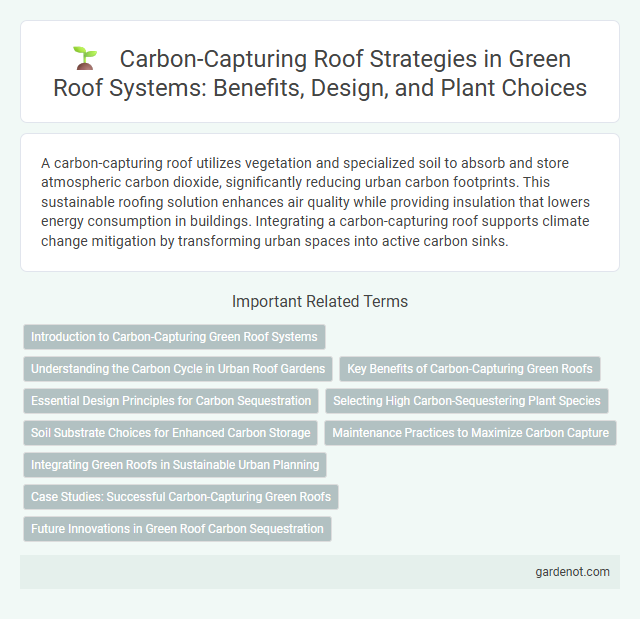A carbon-capturing roof utilizes vegetation and specialized soil to absorb and store atmospheric carbon dioxide, significantly reducing urban carbon footprints. This sustainable roofing solution enhances air quality while providing insulation that lowers energy consumption in buildings. Integrating a carbon-capturing roof supports climate change mitigation by transforming urban spaces into active carbon sinks.
Introduction to Carbon-Capturing Green Roof Systems
Carbon-capturing green roof systems integrate vegetation layers that actively absorb atmospheric carbon dioxide, reducing urban carbon footprints significantly. These roofs consist of specialized plant species and substrates designed to maximize photosynthesis and carbon sequestration while improving insulation and stormwater management. Implementing carbon-capturing green roofs supports climate mitigation by transforming building surfaces into functional carbon sinks.
Understanding the Carbon Cycle in Urban Roof Gardens
Urban roof gardens play a crucial role in the carbon cycle by capturing atmospheric CO2 through photosynthesis and storing it in plant biomass and soil organic matter. Vegetation on green roofs increases carbon sequestration capacity compared to conventional roofs, reducing the urban carbon footprint and mitigating climate change impacts. Optimizing plant species selection and soil management enhances the carbon storage potential of carbon-capturing roofs in densely built environments.
Key Benefits of Carbon-Capturing Green Roofs
Carbon-capturing green roofs significantly reduce atmospheric CO2 by absorbing carbon through plant photosynthesis and soil microbial activity. They improve urban air quality, mitigate the urban heat island effect, and enhance building energy efficiency by providing natural insulation. These roofs also support biodiversity, manage stormwater runoff, and contribute to sustainable urban development.
Essential Design Principles for Carbon Sequestration
Green roofs designed for carbon sequestration integrate deep soil layers and diverse native plants to maximize biomass growth and carbon uptake. Incorporating lightweight, nutrient-rich substrates enhances microbial activity essential for long-term carbon storage in the soil. Optimizing drainage and root aeration prevents soil compaction, sustaining continuous carbon capture and minimizing greenhouse gas emissions.
Selecting High Carbon-Sequestering Plant Species
Selecting high carbon-sequestering plant species for carbon-capturing green roofs significantly enhances their capability to reduce atmospheric CO2. Native perennial grasses, sedums, and certain succulents demonstrate superior carbon uptake due to their extensive root systems and high biomass production. Incorporating these species optimizes long-term carbon storage, biodiversity, and overall roof ecosystem resilience.
Soil Substrate Choices for Enhanced Carbon Storage
Selecting soil substrates rich in organic matter and biochar significantly enhances carbon sequestration in green roofs by increasing microbial activity and soil carbon retention. Incorporating lightweight, nutrient-dense substrates such as compost-amended sandy loam promotes plant growth and maximizes photosynthetic carbon capture. Optimizing substrate pH and moisture retention further stabilizes carbon compounds, extending the duration of carbon storage in urban green roof ecosystems.
Maintenance Practices to Maximize Carbon Capture
Regular inspection and upkeep of green roof vegetation, including pruning and replanting native species, enhance carbon sequestration by promoting healthy plant growth. Maintaining optimal soil moisture and nutrient balance through precise irrigation and organic fertilization supports microbial activity vital for carbon storage. Preventing soil erosion and removing debris ensures long-term carbon retention and maximizes the roof's environmental benefits.
Integrating Green Roofs in Sustainable Urban Planning
Integrating green roofs into sustainable urban planning enhances carbon capture by promoting vegetation that absorbs CO2 emissions and mitigates urban heat islands. These carbon-capturing roofs improve air quality while supporting biodiversity and reducing stormwater runoff. Urban planners prioritize green infrastructure solutions like green roofs to achieve climate resilience and comply with environmental regulations.
Case Studies: Successful Carbon-Capturing Green Roofs
Case studies of carbon-capturing green roofs reveal significant reductions in urban CO2 levels, with projects like the Chicago City Hall green roof capturing up to 12 tons of carbon annually. Research at the University of Toronto demonstrated a 2.4 kg/m2 carbon sequestration potential over five years through extensive green roof installations. These successful implementations highlight the scalability and effectiveness of carbon-capturing green roofs in mitigating climate change within metropolitan environments.
Future Innovations in Green Roof Carbon Sequestration
Future innovations in green roof carbon sequestration include integrating biochar-infused soil substrates and advanced microbial communities that enhance carbon capture efficiency. Emerging technologies focus on smart sensor systems to monitor real-time carbon flux and optimize plant performance for maximum CO2 absorption. Research into genetically modified vegetation with higher photosynthetic rates promises to significantly increase long-term carbon storage capacity on urban rooftops.
Carbon-capturing roof Infographic

 gardenot.com
gardenot.com